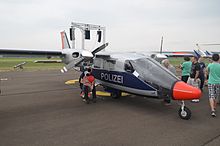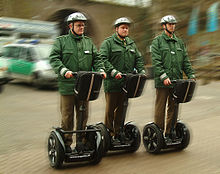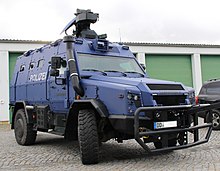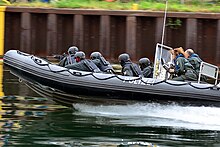








Landespolizei (German for 'state police'; German pronunciation: [ˌlandəspoliˈt͡saɪ] ⓘ) is a term used to refer to the state police of any of the states of Germany.[1]
History[edit]
The Landespolizei of today can trace its origins to the late 19th century, when Germany united into a single country in 1871, under Otto von Bismarck. Various towns and cities also maintained police forces, as the increasing number of new laws and regulations made controlling urban life more complicated.[2][3]
In Nazi Germany, all state and city forces were absorbed into the Ordnungspolizei, which existed from 1936 to 1945.[4]
After World War II, massive numbers of refugees and displaced persons, hunger and poverty characterised everyday life in Germany. Attacks by armed gangs, robbery, looting and black-marketing were commonplace, and the military police could not cope with this troubling security situation. Thus each of the Western Allies quickly permitted the formation of civilian police forces, including small numbers of heavily armed and military like organised police forces in Western Germany, under terms that reflected their own police structures and traditions.
In all three Western zones, the emphasis was to decentralise, demilitarise and democratise the police. Some restrictions were lifted as Cold War tensions grew, and certain police functions necessitated central rather than local direction. The Landespolizei became the police force for the federal states in the West.
East Germany created a unified national force in the form of the Volkspolizei, however this was reorganized according to the West German police upon the reunification of Germany in 1990.
Organisation[edit]

All state police forces in the Federal Republic of Germany are subordinate to their respective Land (State) Minister of the Interior. The internal structures of these police forces differ somewhat (which makes generalizations subject to local variations), but in most cases, immediately subordinate to the interior ministries are the regional police headquarters (Präsidium). These headquarters direct operations over a wide area or in a big city, and have administrative and supervisory functions. The Präsidium often has direct control of the force's specialist units, such as highway patrols, mounted police detachments and canine units.
Under the regional headquarters, there are several district police headquarters (Direktionen) serving communities of from 200,000 to 600,000 citizens. Subordinate to each Direktion, there are several local stations (Inspektion) or precincts (Revier) that are staffed on a 24-hour basis, conduct day-to-day policing and serve as points of contact for local citizens. Below this level, the Polizeiposten are small police offices staffed by one or two officers, normally only during office hours.
Territorial[edit]

The State Police wear the state patch on the uniform sleeve and sometimes metal city badges are worn over the right breast pocket, indicating which police department they work for. Police officers can be transferred anywhere within their state.
Once skilled, officers of the state police can be moved theoretically nationwide. In practice, such requests are made by the officers themselves. They usually swap workplaces with an exchange partner from another federal state ('Stellentausch', job rotation). Such an exchange is thus possible nationwide and is not dependent on the state.[5][6]
Operational[edit]
State police forces are divided into the following branches:
- Schutzpolizei ("Schupo") - the uniformed police officers who patrol the streets and respond to emergency calls etc.
- Bereitschaftspolizei (BePo) - Uniformed units of the LaPo or Federal Police that provide additional manpower for the Schupo in cases of natural disasters, sporting events, traffic control or demonstrations. In 1950 the Bepo was founded as a paramilitary police force whose main task today is riot/crowd control.
In some states the police academy is still part of the Bepo. After qualifying as a police officer, officers have to serve one to two years with the Bepo before moving on to law enforcement duties at a police station.
- Verkehrspolizei - The traffic police in Germany.
- Autobahnpolizei - The highway patrol in Germany. In some states the Autobahnpolizei is a sub division of the Verkehrspolizei department.
- Wasserschutzpolizei (WSP) - The river police for patrolling rivers, lakes and harbours. For practical reasons the WSP of one state may be in charge for territory of another state (e.g., in Hamburg, the WSP is in charge for the Elbe River in the states of Mecklenburg-Vorpommern, Lower Saxony, Schleswig-Holstein and Hamburg.)
- Wachpolizei ("Wapo") - Officers protecting buildings, embassies or pretrial suspects.
- Kriminalpolizei ("Kripo") - the detective branch, responsible for most investigations. For instance, if a car is broken into, the Schupo will respond, secure the car, notify the owner etc., and then hand the case over to Kripo for investigation.
- Landeskriminalamt (LKA) - State Investigation Bureau supervises police operations aimed at preventing and investigating criminal offences, and coordinates investigations involving more than one Präsidium. Some crimes are exclusive LKA missions such as crimes against the constitution, organized crime, youth gangs or political motivated crime.
Dedicated to the LKA:
- Spezialeinsatzkommando (SEK) - The police tactical units of the German state police.
- Mobiles Einsatzkommando (MEK) - The MEKs are plainclothes teams of the LKA with specialised observation and arrest duties.
- Personenschutzkommando - Personal security plainclothes unit, protecting politicians and VIPs.
Training[edit]
The individual Länder and the Federal Police conduct basic police training for their personnel. The length and thoroughness of this training contributes in large degree to the high level of police professionalism in Germany. Teaching all aspects of police work takes time but supports a "uniform career structure" that aims to avoid premature specialization, lets officers think in broad terms, makes career field changes easier and improves promotion opportunities.
German citizenship is not required to be a police officer in Germany. Police departments in big cities are especially keen to recruit officers from ethnic minorities to reduce language and cultural barriers. However, minorities still make up less than one percent of officer numbers.
The Land police have had women members since the forces were reconstituted after World War II. Initially, female officers were only assigned to cases involving juveniles and women but in the mid-1970s they were allowed to become patrol officers. The proportion of women on patrol duty is set to rise as 40-50 percent of police school inductees are currently female.
Most police recruits are taken on directly after leaving school and spend about two and a half years at police school in combined classroom tuition and on-the-job training with police departments and the Bereitschaftspolizei. These people qualify as regular police officers and wear light blue stars on their shoulder straps, denoting rank in the first echelon of the police service.
After duty as a patrol officer, someone with an outstanding record or wealth of experience can go on to two or three years at a higher police school or college of public administration to qualify for the upper echelon which starts with Polizeikommissar (one silver star) and ascends to Erster Polizeihauptkommissar (five silver stars). Direct entry candidates with the Abitur high school diploma can also take these courses. Some states such as Hessen now train all their police officers for the upper echelon to improve pay and promotion chances.
The very few candidates who qualify for the police service's executive ranks study for one year at a state police academy and then for another at the German Police University (Deutsche Hochschule der Polizei – DHPol) in Münster-Hiltrup where graduates earn a master's degree in police administration. Direct-entry candidates with a university degree only study for six months at the DHPol. The executive echelon begins with Polizeirat (one gold star) and culminates with the Land chief of uniformed police (gold wreath with one to three stars) or Federal Police chief (gold wreath with four stars). The DHPol that the states and Federal Interior Ministry administer jointly also provides specialized vocational courses for senior police personnel.
Sidearm[edit]
All Landespolizei officers carry handguns while on duty. Each German state's Landespolizei differ from other states in what sidearm they carry; this list includes some of the weapons utilized by various Landespolizei, as well as weapons that have been phased out:
- Heckler & Koch USP- P10 variant was adopted by Thuringia State Police and Saxony State Police [7]
- Heckler & Koch P30- Used by Hesse State Police[8]
- Heckler & Koch VP9- Procurred by Saxony State Police, Mecklenburg-Vorpommern State Police, Lower Saxony State Police, the Brandenburg State Police, the Bavarian State Police[9] and the Berlin Police[10][11][12]
- Heckler & Koch P7- Was used by the Bavarian State Police[13]
- Sig Sauer P226- Used by Special Deployment Commando of the 16 State Police Forces and several state police forces (currently under replacement)
- Walther P5- Used by Lower Saxony State Police (replaced by P2000 and later VP9)
- Walther P99- Utilized by North Rhine-Westphalia Police, Bremen, Hamburg, Schleswig-Holstein[14] and Rhineland-Palatinate State Police[15]
- HK P2000 used by the Baden-Württemberg Police, the Hamburg water police and state police of Lower Saxony
Appearance[edit]




Post WWII[edit]
From 1945 till 1976, the various Länder had a wide array of insignia and rank. Additionally, uniforms colours varied from green to blue, and various shades thereof. For example, the City State of Hamburg police NCOs wore blue uniforms with inverted British style chevrons and the Schleswig Holstein police wore green uniforms with Third Reich style rank. Bavaria maintained a State Police (Landespolizei) as well as City Police (Gemeinde / Stadt) forces and, as a special feature, an own Border Police (Bayerische Grenzpolizei). Two separate and distinct uniforms were worn during this time by the state police (Green) and City Police (Blue). The last city police force was Munich, which was finally merged into the state police in 1975. This organization was also prevalent in the other American Sector states.
Green uniforms[edit]
From 1945 all German police forces wore different coloured uniforms, but beginning in the mid-seventies the police of all West German Länder and West Berlin wore the same uniform that Heinz Oestergaard designed most parts of in the early seventies. The standard uniform consisted of a tunic, parka, pullover without shroud, coat, visor cap and necktie in moss-green, trouser, pullover, and cardigan in brown-beige, and shirt (long and short sleeve) in bamboo-yellow. Shoes, boots, holsters, leather jackets, and other leather gear were black. Leather gloves were olive drab. Exceptions were the visor caps with a white top worn by the Verkehrspolizei, or traffic police. The Verkehrspolizei wore white gloves, tunics, and coats during traffic duties and ceremonial duties (like white holsters and leather gear). In some Länder all officers wore visor caps with white tops in general. The Wasserschutzpolizei wore uniforms of a slightly different design. They had dark or navy-blue jackets, the shirt was white, and the visor cap had a white top. The BGS wore a forest green uniform with a bamboo-yellow shirt. After German reunification, the Volkspolizei was broken up into Landespolizei and switched to the standard uniform. During the period of transition they still wore their old uniforms, but with western-style sleeves and cap emblems.
Vehicle markings were also redesigned to conform to a white and green livery with the legend "Polizei" in bold lettering.
Blue uniforms[edit]
All German State Police Forces (German: Landespolizei) and the Federal Police (German: Bundespolizei) shifted after 2005 to blue uniforms to conform with the common blue look of most police forces in Europe. In line with the uniforms, police vehicles and various items of equipment also changed their main color to blue. Although there are 16 states, currently only six types of state police uniforms are in use, because many states co-operate in the design and sourcing of the police uniforms. Cap badges, patches and rank remain the same as before, just in blue. Vehicle liveries also changed to a silver/blue or white/blue design.
| State Police Force | Police uniform type | Launched in | Conversion finished in | Conversion to blue patrol cars |
|---|---|---|---|---|
| Baden-Württemberg State Police | Baden-Württemberg | 2010 | 2011 | 2008 |
| Bavarian State Police | Bavaria: a modification of the Austrian federal police uniform | 2016 | 2018 | 2016 |
| Berlin State Police | Brandenburg | 2010 | 2013 | 2010 |
| Brandenburg State Police | Brandenburg | 2008 | 2010 | 2005 |
| Bremen State Police | Hamburg | 2006 | 2010 | 2006 |
| Hamburg State Police | Hamburg | 2005 | 2005 | 2002 |
| Hesse State Police | Hesse | 2008 | 2008 | 2005 |
| Lower Saxony State Police | Hamburg | 2006 | 2008 | 2004 |
| Mecklenburg-Vorpommern State Police | Hamburg | 2009 | 2011 | 2009 |
| North Rhine-Westphalia State Police | North Rhine-Westphalia | 2007 | 2012 | 2007 |
| Rhineland-Palatinate State Police | Hesse | 2008 | 2012 | 2006 |
| Saarland State Police | Hesse | 2015 | 2016 | 2015 |
| Saxony State Police | Brandenburg | 2009 | 2012 | 2008 |
| Saxony-Anhalt State Police | mixed uniform type of Brandenburg and Hesse uniform types | 2009 | 2012 | 2006 |
| Schleswig-Holstein State Police | Hamburg | 2006 | 2008 | 2005 |
| Thuringia State Police, running out | Hesse uniform type, running out | 2009 | 2011 | 2006 |
| Thüringen State Police | Hamburg uniform type (new type since 2020) | 2020 | ongoing | 2006 |
Exceptions[edit]
The Bundeskriminalamt (BKA - the German Federal Criminal Police Office) and the Bundespolizei (BPOL - Federal Police, formerly known as the Bundesgrenzschutz/BGS) are federal institutions that are not part of the Landespolizei. Another police is the Polizei beim Deutschen Bundestag (Police at the Bundestag).
See also[edit]
Crime:
References[edit]
- ^ "OSCE entry". POLIS. OSCE. Archived from the original on 2009-05-24. Retrieved 5 May 2019.
- ^ 'Deutsche Einigungskriege' (Wars of German Unification), Bibliographisches Institut & F. A. Brockhaus AG, Mannheim retrieved April 9, 2015
- ^ § 10 II 17, ALR ('Allgemeines Landesrecht für die preußischen Staaten', General state laws for the Prussian states), 1794
- ^ "Lexikon der Wehrmacht - Die Schützenkompanie eines Infanterieregiments in der Infanteriedivision von 1939". www.lexikon-der-wehrmacht.de.
- ^ "§ 15, Beamtenstatusgesetz (Civil Servants Status Act) of Germany". dejure.org. Retrieved April 9, 2015.
- ^ "Job rotation service of the Gewerkschaft der Polizei (Police Union) of Germany". www.gdp.de (in German). Retrieved April 9, 2015.
- ^ "P5 Initials - Page 2 - WaltherForums". www.waltherforums.com. Retrieved 5 May 2019.
- ^ "Super-Pistole: Hessens Polizisten bekommen HK P30". bild.de. Retrieved 5 May 2019.
- ^ "SFP 9: Das ist die neue Feuerwaffe der bayerischen Polizei". merkur.de. 12 January 2018. Retrieved 5 May 2019.
- ^ thvo. "Mecklenburg-Vorpommern: Polizei bekommt 5700 neue Pistolen - svz.de". svz. Retrieved 5 May 2019.
- ^ "Sachsens Polizei kriegt neue Waffen". TAG24. Retrieved 5 May 2019.
- ^ "Niedersachsens Polizei bekommt für 7,5 Millionen Euro neue Pistolen". hna.de. 1 February 2016. Retrieved 5 May 2019.
- ^ "P7 observation while in Munich - Page 2". www.hkpro.com. Retrieved 5 May 2019.
- ^ Gehm, Eckard. "Neue Pistolen: James Bonds Dienstwaffe für Polizisten im Norden | shz.de". shz. Retrieved 2021-12-31.
- ^ "Carl Walther Sportwaffen GmbH". www.carl-walther.de. Archived from the original on 2007-07-02.
External links[edit]
- Official website (in German)